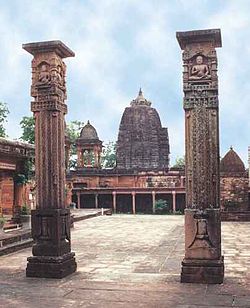Deogarh, Uttar Pradesh
| Deogarh | |
|---|---|
| Village | |

The Shantinath Temple columns in the fort show Jain monks
|
|
| Location in Uttar Pradesh, India | |
| Coordinates: 24°31′34″N 78°14′17″E / 24.526°N 78.238°ECoordinates: 24°31′34″N 78°14′17″E / 24.526°N 78.238°E | |
| Country | India |
| State | Uttar Pradesh |
| District | Lalitpur |
| Government | |
| • Body | Gram panchayat |
| Area | |
| • Total | 10.49 km2 (4.05 sq mi) |
| Elevation | 211 m (692 ft) |
| Population (2011) | |
| • Total | 783 |
| • Density | 75/km2 (190/sq mi) |
| Languages | |
| • Official | Hindi |
| Time zone | IST (UTC+5:30) |
| PIN | 284403 |
| Telephone code | 0517 |
Deogarh is a village in Lalitpur district of the Indian state of Uttar Pradesh. It is located on the right bank of Betwa River and to the west of Lalitpur hills. It is known for Gupta monuments and for many ancient monuments of Hindu and Jain origins are in and outside the walls of the fort.
The Gupta temple dedicated to the Hindu god Vishnu, popularly known as the Dashavatara Temple, is the earliest known Panchyatana temple in North India. The fort on the hill is dominated by a cluster of Jain temples on its eastern part, the oldest of these dating to the 8th or 9th century. Apart from Jain temples, the wall frescoes of Jain images of "iconographic and the stylistic variety", are special features of the fort. The three ghats (ghat means "flight of stone steps leading to the river"), which provide approach to the Betwa river edge from the fort – the Nahar Ghat, the Rajghat and the ghat with the Siddh ki Ghufa (saints cave) – are also of archeological significance.
The Deogarh monuments are protected by the Department of Archaeology of the Archaeological Survey of India (ASI), and managed through its Northern Circle Office located in Agra. ASI maintain an archaeological museum at the Deogarh site, which is noted for its treasured archaeological sculptures.
"Deogarh" derives from the Sanskrit Deo and garh, "God" and "fort", compounded to mean "fort of the Gods". This term, "House of God", is also widely used as a place name for villages in the vicinity of temples within fort-walls throughout India.
Deogarh village, which has an area of 1,049.15 square kilometres (405.08 sq mi), lies on the right bank of the Betwa River, at the point where it joins the reservoir formed by the Rajghat Dam. The village also has two rock cut valleys known as Nahar Ghati (ghati means "valley") and Raj Ghati on its southern side along the river. The village is at the western end of the Lalitpur hill range, situated 33 kilometres (21 mi) south-east from Lalitpur town in Lalitpur district, 125 kilometres (78 mi) south of the divisional administrative centre at Jhansi, and 235 km from Gwalior. The nearest railway station is 12 kilometres (7.5 mi) away at Jhaklon. The village has an average elevation of 211 metres (692 ft).
...
Wikipedia


